Perplexity’s Strategic Expansion into India’s AI Market
While OpenAI dominates the U.S. AI landscape, Perplexity is quietly embarking on an ambitious journey in India. The search-centric AI startup is successfully attracting millions of users in the world’s second-largest internet and smartphone market, gearing up for significant mass-market presence.
Exclusive Partnership with Bharti Airtel
In a significant move this week, Perplexity collaborated with Bharti Airtel, India’s second-largest telecom operator, to provide a complimentary 12-month Perplexity Pro subscription—valued at $200—to all 360 million Airtel subscribers. Airtel confirmed to TechCrunch that this exclusive deal prohibits other telecom providers from offering Perplexity’s services to their customers.
Global Expansion Strategy: Building Volume
The Airtel collaboration marks one of Perplexity’s most noteworthy actions as part of a broader global expansion strategy, which includes alliances with over 25 telecom companies worldwide, such as those recently established with SoftBank in Japan and SK Telecom in South Korea. Given India’s massive population, the startup sees unparalleled opportunities for growth not found in other regions.
Impressive Growth Metrics in India
Perplexity is witnessing remarkable success in India, with downloads skyrocketing 600% year-over-year to 2.8 million in Q2, according to exclusive Sensor Tower data shared with TechCrunch. In comparison, OpenAI’s ChatGPT observed a 587% rise, totaling 46.7 million downloads during the same timeframe.
The uptick in active users mirrors this growth; Perplexity’s monthly active users (MAUs) surged 640% year-over-year in Q2, while ChatGPT’s grew by 350%. India ranked as Perplexity’s largest MAU market last quarter, per Sensor Tower, although ChatGPT still holds a substantial lead with 19.8 million MAUs compared to Perplexity’s 3.7 million.

Leveraging India’s Unique Market Dynamics
Building on prior partnerships, Perplexity aims to utilize India’s substantial user base to leapfrog over mature Western markets where OpenAI currently dominates in paid subscriptions. Earlier this year, it also partnered with Paytm, a leading Indian fintech, to integrate its AI-powered search into the Paytm app, boasting over 500 million downloads and ranking among the top three apps within India’s Unified Payment Interface.
CEO Aravind Srinivas’s Commitment to India
Perplexity’s CEO, Aravind Srinivas, has taken proactive steps to bolster the company’s presence in India. In January, he announced plans to hire an Indian executive, later pausing the initiative due to an “overwhelming” response to the job listing. He has since committed to a $1 million investment and dedicating five hours per week to boost AI initiatives in India.
Targeting Students and Tech-Savvy Users
Sources indicate Perplexity is also considering providing its AI search engine to Indian students to broaden its reach further.
Capitalizing on Limited Local Competition
A key factor for Perplexity’s focus on India is the relatively limited number of local AI startups in the AI search sector, paired with a large base of tech-savvy users. This dynamic has prompted even Google to introduce AI-focused search tools like AI Mode in India ahead of many other regions.
Monetization Challenges and Opportunities
Despite its growth, Perplexity faces significant challenges in monetizing its user base. It still trails far behind ChatGPT globally in revenue generation, despite both platforms offering a comparable $20 monthly subscription. ChatGPT’s in-app purchase revenue reached $773 million in Q2, reflecting a 731% year-over-year increase, while Perplexity reported an increase to $8 million, a 300% growth, as per Sensor Tower data.

Future Potential in an Evolving Market
In India, where consumers are known to be price-sensitive, Perplexity’s monetization strategy will require careful consideration. However, promising indicators exist. ChatGPT’s in-app purchase revenue saw an 800% year-over-year increase to $9 million in India during Q2. While Perplexity hasn’t captured notable in-app revenue yet, partnerships like the one with Airtel present opportunities for subscription growth in the short term.
Attracting Investment through User Growth
Strategic alliances in markets like India could position Perplexity favorably in front of investors who prioritize user growth and geographic diversification. To ensure sustained support, the startup must demonstrate the ability to convert its expanding user base into revenue streams.
Srinivas did not respond to requests for comment.
FAQs about Perplexity and Its Strategy in India
-
What is Perplexity’s main goal in India?
- Perplexity aims to establish a strong foothold in India’s rapidly growing technology market. By leveraging local talent and resources, the company seeks to innovate and compete effectively against giants like OpenAI.
-
How does Perplexity plan to compete with OpenAI?
- Perplexity is focusing on developing unique AI solutions tailored to the needs of the Indian market. This includes enhancing natural language processing capabilities and integrating AI into everyday applications, providing a niche that differentiates it from OpenAI’s offerings.
-
What advantages does India offer to Perplexity?
- India provides a vast pool of skilled tech professionals, a burgeoning startup ecosystem, and increasing investment in AI and technology sectors. This environment fosters innovation and collaboration, allowing Perplexity to accelerate its growth.
-
Are there specific sectors in India where Perplexity will focus its efforts?
- Yes, Perplexity plans to concentrate on sectors like healthcare, education, and finance, where AI can drive significant improvements and create impactful solutions that align with local needs.
- What are the potential challenges Perplexity might face in India?
- Challenges include intense competition from both local startups and established global players, navigating regulatory landscapes, and adapting to diverse consumer preferences across regions in India.




